originally posted at https://canmom.tumblr.com/post/704373...
Hi everyone. Hope you’re enjoying any winter holidays that take your fancy. (Hanukkah sameach!) According to Annex 3 of Animation Night Policy we do not observe “christmas” - instead, let me tell you a tale of the past…
Mukashi mukashi… back in the distant misty era of 2020, an era of bloodshed and plague and impending social change (we hope), I wrote the longest Animation Night ever.
Which mostly wasn’t actually about animation at all, but an excuse to infodump about samurai. Armed with a book with the exciting title of Japan to 1600: A Social and Economic History, I wrote at great length about everyone’s favourite feudal landlord-administrator-soldier class, and the genres of fiction that portray them…

Japanese revision time! 時代劇 jidaigeki basically just means ‘period drama’, and it needn’t have anything to do with samurai at all. Indeed, just a couple of weeks ago we watched Rintaro’s adaptation of Teito Monogatari, which qualifies as a jidaigeki despite taking place entirely in the 20th century. チャンバラ (chanbara) is a little narrower, referring to samurai films with an emphasis on the swordfighting.
Animation Night revision time! On AN 24, we watched oldschool films like Namakura Gatana [1917] and Benkei tai Ushiwaka [1939] along with Sword of the Stranger and Afro Samurai, and a small sampling of Seirei no Moribito, Samurai Champloo. Elsewhen, on AN 100 we watched The Tale of Princess Kaguya, Winter Days and Mononoke-hime, on AN 91 we marathoned Naoko Yamada’s incredible adaptation of Heike Monogatari, and on AN 122 we did the same for animation milestone The Hakkenden.
So are we out of animated films about samurai? Ha! No we ain’t.

The occasion this time? I’m itching to show you all Inu-Oh, but Science Saru are holding it tight to their chest at the moment. But there is something else!
Nahoko Uehashi is an ethnologist turned fantasy author, known for her works like Seirei no Moribito (Guardian of the Sacred Spirit) and Kemono no Sōja (The Beast Player), both of which have been adapted to anime by Production IG. In the first, Balsa, a bodyguard atoning for seven deaths, is entrusted with a young prince marked for death by his father - a prince who is, unknown to all, incubating a strange force of spiritual renewal. In the second, Erin, a girl from a culture being genocided, inherits the skill to control animals through her music and thus finds herself drawn into feudal politics.
Neither is exactly set in historical Japan, but that’s in the same way that most Western fantasy isn’t exactly set in medieval Europe. Both have a kind of thoughtful, slightly oldschool tone - highly attentive to nature, and avoiding simple heroes and villains. And Production I.G. - despite being a studio known primarily for scifi - turned out to be a perfect match.
Well, earlier this year, Production IG released their latest adaptation of Uehashi’s works in the form of 鹿の王 Shika no Ō (The Deer King). Co-director Masashi Andō has been a key animator for many many years, and in that time managed to work with just about anyone you’ve ever heard of. He drew for Ghibli under both Miyazaki and Takahata on nearly everything, for Satoshi Kon on Tokyo Godfathers, Paranoia Agent and Paprika, for 4C on Tekkonkinkreet, for Makoto Shinkai on Your Name, for Mitsuo Iso on Dennō Coil, for Mamoru Oshii on GitS 2: Innocence, for Anno on Eva 3.0… A glance over his sakugabooru page will show you why: he’s an expert in the realist tradition, not quite as flashy as some of his peers like Ohira or Inoue, but with a fantastic sense of naturalistic motion and an ease at drawing all sorts of weird angles.
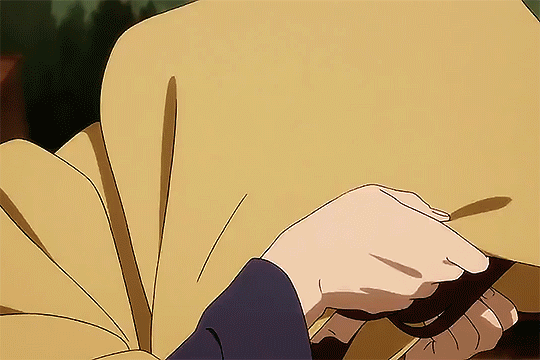
The Deer King was Andō’s first time directing, so he was joined by Masayuki Miyaji, who worked himself up from being a production assistant at Ghibli to storyboarding on a whole long list of TV anime, and acting as one of two ‘assistant directors’ (not entirely sure what that entails) on Spirited Away, before hopping into the director’s chair with Xam’d at Bones in 2008-09. Miyaji is of the school that situations animation within film at large, taking inspiration mostly from live action - or at least he was at the time of Xam’d.
So what’s it about? In a feudal setting cut up by war and plague, a slave and a young girl survive an attack by plague-carrying dogs and make their escape, hoping for a peaceful life - a classic Uehashi adoptive parent situation. But with the plague running rampant, prejudice everywhere, and the empire’s doctors searching for a cure, they won’t get it. It’s a lot of novel to pack into one film, and I’m warned that it struggles a little to contain it all, but Ando’s enormous experience shines through to give a film full of subtle and expressive animation.
Anyway, it’s one I’ve had my eye on for ages, so I’m really eager to watch it with you.
Now, let’s roll back the clock a bit. No, not quite to the sengoku jidai - 2012 will do. The Annecy International Film Festival is weighing up a massive slate, including a couple you may remember like Wrinkles (AN 87) and Children who Chase Lost Voices (AN 132). But there’s an odd little one tucked in there: a film by Toei, adapting the 70s manga Asura by George Akiyama. It’s a story set at the beginning of the sengoku period, where drought and famine wrack Kyoto, following a feral child who survives an attempted cannibalistic infanticide as he grows up amid all the war and devastation. Buddhas will be carved, symbolically. It’s that kinda thing.
George Akiyama was controversial in his day for his depictions of suicide, self-mutilation and cannibalism; ComiPress called him the ‘unstoppable king of trauma manga’. After making a serious impact with a bleak apocalyptic sci-fi story inspired by the infamous Maoist cult the Japanese Red Army, and even more so with an autobiography in which he revealed he had mixed Japanese-Korean parents (inspiring Big Racisms in those days), he surprised everyone by retiring. It didn’t stick. He moved from scandalising Shōnen Jump readers to adult manga, then back, uncannily anticipating the Aum terrorist attacks. He sounds like a fascinating guy and I’d like to read him some of that. Maybe it will be a Comics Comints one day. Hehe.
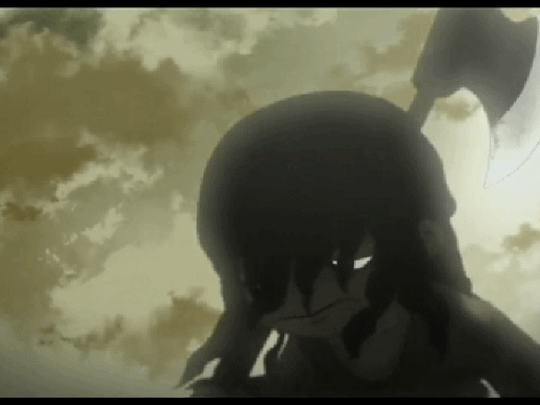
The most curious thing about Toei’s adaptation is the animation method. It’s very common now to place 2D animation in 3D scenes, but here we see the opposite: traditionally painted backgrounds populated by stylised 3D characters. Viewed with modern eyes, it has an interesting, uncanny look - certainly videogamey, but I’m curious to see how it works in a larger film. This CG approach may seem less odd when we consider director Keiichi Sato had the year before directed Tiger & Bunny at Sunrise, whose story of corporate-funded superheroes needed CG to plaster logos across the suits. Sato would actually later go on to mostly work in live-action film, notably the adaptation of Gantz we watched on Toku Tuesday 40.
I can’t guess what we’ll all make of Asura. It could be really great, a neglected classic like Birdboy - or it could end up being so exaggeratedly grimdark as to end up kind of goofy. We’ll find out! Animation Night would be no fun if we stuck to the well-known roads. At a brief 75 minutes, Asura is a pretty digestible size like an OVA episode.
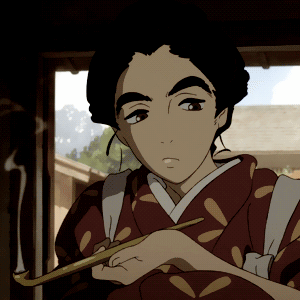
After all that war and death, we probably want a breather. 百日紅 Sarusuberi (Miss Hokusai) looks at a different aspect of history - the renowned ukiyo-e painter Hokusai, best known for that one wave you might have seen here and there. Hokusai, it turned out, had a daughter called Katsushika Ōi, who followed her dad’s footsteps into ukiyo-e. Her story caught the eye of mangaka Hinako Sugiura.
Sugiura is another one I’ve got to have a look into. A manga artist with a deep interest in history, particularly the Edo period, she learned manga from Murasaki Yamada - not just a regular in the pages of Garo magazine, the fascinating alternative manga magazine, but a feminist essayist and a poet. Sugiura also debuted in Garo, drawing on ukiyo-e to great effect for her historical manga. She retired from manga in 1993 to focus on her research, and became something of a TV personality, supplying NHK with information on the Edo period for a comedy program.
The film intercuts Ōi’s life with her dad’s, a series of episodic stories in which we meet other painters from the period and watch Ōi growing up in the Edo period, working uncredited and trying to figure out sexuality. The animation comes from a studio called… Production I.G…. hmm I think I’ve heard of those guys?
So this time, the director was Keiichi Hara. While Masashi Andō was enjoying that wide-ranging career with all the big name directors, Hara was doing one thing, and that was directing Doraemon and Crayon Shin-Chan for Shin-ei. Two of the absolutely largest anime franchises in Japan, they don’t get a lot of play abroad - but then one is a kids’ series and the other leans heavily on Japanese wordplay so it’s not entirely surprising. From 1984 to 2005, Hara directed a movie for one of these two franchises nearly every year…
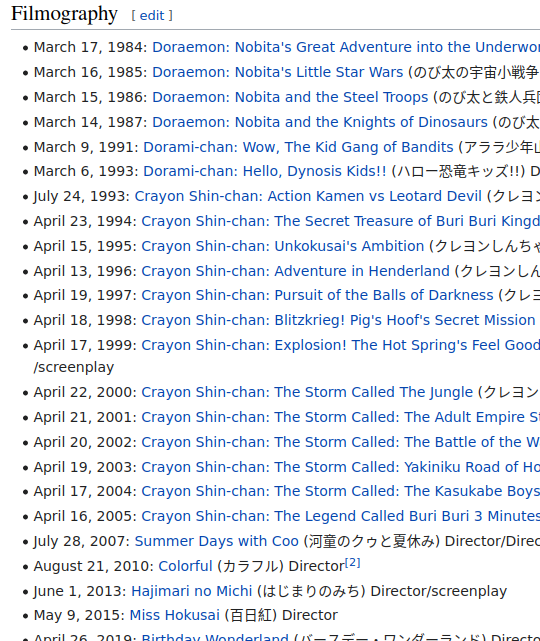
…I’m not kidding!
Anyway, it seems that in 2005 he decided he’d had enough (I can only assume) and from that point on he started directing non-franchise films. Quite a few of them actually - something for a future Animation Night, perhaps.
With Miss Hokusai, Hara could call on Production I.G. legends like Toshiyuki Inoue and Norio Matsumoto to realise a detailed, grounded Edo Period in exquisite detail. The clips I’ve seen look beautiful - I’ll try and have more than that to say later, but I am absolutely categorically out of time at this point.
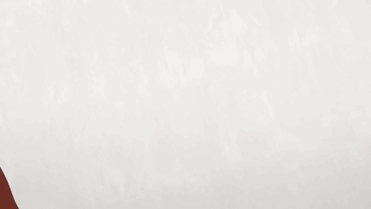
So! Two Production I.G.s doing what Production I.G. do best, and a little oddity of Toei’s. If you’re willing to indulge me, please head over to
-> twitch.tv/canmom <-
for some mobies!
We may be up a bit late by UK standards, but I hope you can hop in for a bit, as suits! Movies will start in about 20 minutes (~21:20 UK time), modulo audience. See you theeerrreeeeeee!
Comments